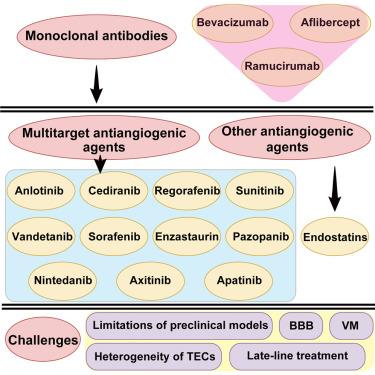Current evidence and challenges of multitarget anti-angiogenic agents for glioblastoma: Results from clinical trials
IF 4.1
2区 综合性期刊
Q1 MULTIDISCIPLINARY SCIENCES
引用次数: 0
Abstract
Glioblastoma (GBM) is a highly vascularized and aggressive brain tumor with a dismal prognosis. This systematic review critically appraises clinical evidence for multitarget anti-angiogenic agents, which inhibit pathways such as VEGFR, FGFR, and PDGFR. Most supporting data come from small, single-arm phase II trials or retrospective studies. Five challenges are highlighted: (i) translational shortcomings of current preclinical models, (ii) restriction of agent delivery by the blood-brain barrier (BBB), (iii) heterogeneity of tumor endothelial cells (TECs) driving intrinsic and adaptive resistance, (iv) angiogenic escape via vasculogenic mimicry (VM), and (v) a lack of consensus on late-line treatment for recurrent GBM (rGBM). Future research should prioritize robust biomarker development, brain-penetrant agents, strategies tailored to specific TEC subtypes, and disruption of VM to unlock the full therapeutic potential of anti-angiogenic agents in GBM. This review provides an evidence-based foundation and translational research guidance for clinicians and pharmaceutical researchers.

多靶点抗血管生成药物治疗胶质母细胞瘤的当前证据和挑战:临床试验结果
胶质母细胞瘤(GBM)是一种高度血管化的侵袭性脑肿瘤,预后不佳。本系统综述批判性地评估了多靶点抗血管生成药物的临床证据,这些药物抑制VEGFR、FGFR和PDGFR等途径。大多数支持数据来自小型单臂II期试验或回顾性研究。强调了五个挑战:(i)当前临床前模型的翻译缺陷,(ii)血脑屏障(BBB)对药物递送的限制,(iii)肿瘤内皮细胞(tec)的异质性驱动内在和适应性抵抗,(iv)通过血管生成模拟(VM)的血管生成逃逸,以及(v)对复发性GBM (rGBM)的晚期治疗缺乏共识。未来的研究应优先考虑强大的生物标志物开发、脑渗透剂、针对特定TEC亚型的策略和VM破坏,以释放抗血管生成药物在GBM中的全部治疗潜力。本文综述为临床医生和药学研究人员提供了循证基础和转化研究指导。
本文章由计算机程序翻译,如有差异,请以英文原文为准。
求助全文
约1分钟内获得全文
求助全文
来源期刊

iScience
Multidisciplinary-Multidisciplinary
CiteScore
7.20
自引率
1.70%
发文量
1972
审稿时长
6 weeks
期刊介绍:
Science has many big remaining questions. To address them, we will need to work collaboratively and across disciplines. The goal of iScience is to help fuel that type of interdisciplinary thinking. iScience is a new open-access journal from Cell Press that provides a platform for original research in the life, physical, and earth sciences. The primary criterion for publication in iScience is a significant contribution to a relevant field combined with robust results and underlying methodology. The advances appearing in iScience include both fundamental and applied investigations across this interdisciplinary range of topic areas. To support transparency in scientific investigation, we are happy to consider replication studies and papers that describe negative results.
We know you want your work to be published quickly and to be widely visible within your community and beyond. With the strong international reputation of Cell Press behind it, publication in iScience will help your work garner the attention and recognition it merits. Like all Cell Press journals, iScience prioritizes rapid publication. Our editorial team pays special attention to high-quality author service and to efficient, clear-cut decisions based on the information available within the manuscript. iScience taps into the expertise across Cell Press journals and selected partners to inform our editorial decisions and help publish your science in a timely and seamless way.
 求助内容:
求助内容: 应助结果提醒方式:
应助结果提醒方式:


